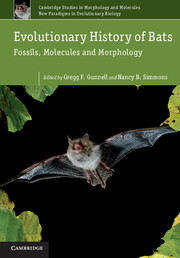Book contents
- Frontmatter
- Contents
- Contributors
- Preface
- 1 Phylogenies, fossils and functional genes: the evolution of echolocation in bats
- 2 Systematics and paleobiogeography of early bats
- 3 Shoulder joint and inner ear of Tachypteron franzeni, an emballonurid bat from the Middle Eocene of Messel
- 4 Evolutionary history of the Neotropical Chiroptera: the fossil record
- 5 New basal noctilionoid bats (Mammalia: Chiroptera) from the Oligocene of subtropical North America
- 6 Necromantis Weithofer, 1887, large carnivorous Middle and Late Eocene bats from the French Quercy Phosphorites: new data and unresolved relationships
- 7 African Vespertilionoidea (Chiroptera) and the antiquity of Myotinae
- 8 Evolutionary and ecological correlates of population genetic structure in bats
- 9 A bird? A plane? No, it's a bat: an introduction to the biomechanics of bat flight
- 10 Toward an integrative theory on the origin of bat flight
- 11 Molecular time scale of diversification of feeding strategy and morphology in New World Leaf-Nosed Bats (Phyllostomidae): a phylogenetic perspective
- 12 Why tribosphenic? On variation and constraint in developmental dynamics of chiropteran molars*
- 13 Necromantodonty, the primitive condition of lower molars among bats
- 14 Echolocation, evo-devo and the evolution of bat crania
- 15 Vertebral fusion in bats: phylogenetic patterns and functional relationships
- 16 Early evolution of body size in bats
- Index
- Plate section
- References
6 - Necromantis Weithofer, 1887, large carnivorous Middle and Late Eocene bats from the French Quercy Phosphorites: new data and unresolved relationships
Published online by Cambridge University Press: 05 June 2012
- Frontmatter
- Contents
- Contributors
- Preface
- 1 Phylogenies, fossils and functional genes: the evolution of echolocation in bats
- 2 Systematics and paleobiogeography of early bats
- 3 Shoulder joint and inner ear of Tachypteron franzeni, an emballonurid bat from the Middle Eocene of Messel
- 4 Evolutionary history of the Neotropical Chiroptera: the fossil record
- 5 New basal noctilionoid bats (Mammalia: Chiroptera) from the Oligocene of subtropical North America
- 6 Necromantis Weithofer, 1887, large carnivorous Middle and Late Eocene bats from the French Quercy Phosphorites: new data and unresolved relationships
- 7 African Vespertilionoidea (Chiroptera) and the antiquity of Myotinae
- 8 Evolutionary and ecological correlates of population genetic structure in bats
- 9 A bird? A plane? No, it's a bat: an introduction to the biomechanics of bat flight
- 10 Toward an integrative theory on the origin of bat flight
- 11 Molecular time scale of diversification of feeding strategy and morphology in New World Leaf-Nosed Bats (Phyllostomidae): a phylogenetic perspective
- 12 Why tribosphenic? On variation and constraint in developmental dynamics of chiropteran molars*
- 13 Necromantodonty, the primitive condition of lower molars among bats
- 14 Echolocation, evo-devo and the evolution of bat crania
- 15 Vertebral fusion in bats: phylogenetic patterns and functional relationships
- 16 Early evolution of body size in bats
- Index
- Plate section
- References
Summary
Introduction
In 1887, Weithofer described the fossil bat Necromantis adichaster on the basis of fragmentary material from the Paleogene Quercy phosphorite fillings of southwestern France. The Phosphorites are composed mostly of phosphate-rich clays, including fossil materials, that fill the caves and fissures riddling the karstic landscape in the large regional Quercy area (including parts of four departments, but mostly the Lot and Tarn-et-Garonne) and extending west to the hills of the Massif Central (e.g., Thévenin, 1903; Gèze, 1938). The fillings were deposited over a period of about 30 million years from the late Early Eocene to the late Early Miocene (e.g., Legendre et al., 1997), but also as recently as the Late Pliocene and Quaternary (Crochet et al., 2006; Aguilar et al., 2007).
From 1870 to 1907, many mines were established in the Quercy region to exploit the naturally occurring phosphate, a widely used fertilizer, with much of the Quercy ore being exported (see Durand-Delga, 2006 for a detailed history of the Quercy mining operations). Geologists were rarely allowed to visit the localities during the mining period, with fortunate exceptions, including Trutat, who took photographs (see Duranthon and Ripoll, 2006), and Thévenin, who produced a learned report (Thévenin, 1903). During the c. 40 years of intensive mining, the Quercy Phosphorites became renowned for producing many fossil bones and teeth, in good and even exceptional condition (Daubrée, 1871; Delfortrie, 1872). Today the Quercy Phosphorites are globally recognized for the thousands of vertebrate fossils they have produced, including many specimens of bats. For a recently updated record of Quercy micromammals see Sigé and Hugueney (2006) and for a catalog of classic Quercy mammalian taxa (i.e., before more recent excavations) see Sigé et al. (1979).
- Type
- Chapter
- Information
- Evolutionary History of BatsFossils, Molecules and Morphology, pp. 210 - 251Publisher: Cambridge University PressPrint publication year: 2012
References
- 2
- Cited by



